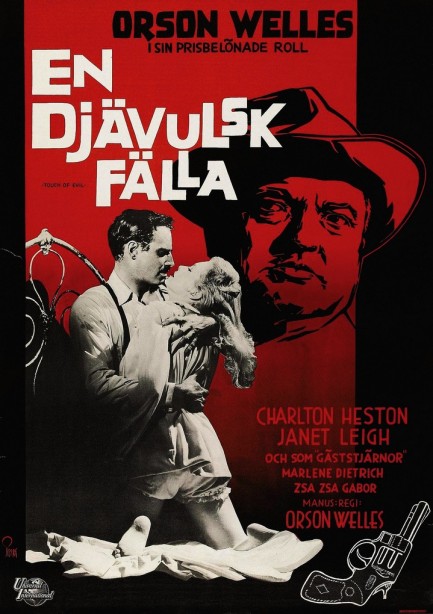| Vintage Pulp | Oct 14 2009 |

Orson Welles makes a run to the border.

It has the most famous one-take tracking shot in cinema history, it’s the last of the official film noirs (unless you’re one of those Kiss Me Deadly purists), and it was directed by distinguished filmmaker Orson Welles. It was called Touch of Evil, and above you see its moody Swedish laguage poster. Though the film has its flaws, the technical prowess on display is indisputable. At this point film noir was a well-charted phenomenon in which Welles had already dabbled when he made Lady from Shanghai and The Stranger. This time out, he wanted to fully explore the possibilities of shadow the way a painter might explore the possibilities of oils. Everyone knew black-and-white was on the way out. Touch of Evil was Welles’ commentary on the style. He was showing the world what was possible, and by extension, what might be impossible using color.
The casting of Charlton Heston as Ramón Miguel Vargas has been thoroughly discussed pretty much everywhere, and those criticisms are understandable. Certainly, an actor such as, say, Ricardo Montalbán would have shone where Heston merely sufficed, but 1958 audiences would have disliked lily white Janet Leigh being hooked up with an actual Latino actor. People overlook that when they criticize Heston's casting. Welles made a racial statement by swapping the ethnicities of the central couple from Whit Masterson's source novel, in which the cop was white and his wife was Mexican. That's as far as he was willing to go. Cinema mirrors the age in which it was produced. It’s okay to use our modern world as a prism through which to examine the circumstances around an old film, but it’s best do so respectfully, because somewhere in the future people with their own prisms will be looking upon our age, and it won’t look so good to them. Touch of Evil played in Sweden for the first time today in 1958.
The casting of Charlton Heston as Ramón Miguel Vargas has been thoroughly discussed pretty much everywhere, and those criticisms are understandable. Certainly, an actor such as, say, Ricardo Montalbán would have shone where Heston merely sufficed, but 1958 audiences would have disliked lily white Janet Leigh being hooked up with an actual Latino actor. People overlook that when they criticize Heston's casting. Welles made a racial statement by swapping the ethnicities of the central couple from Whit Masterson's source novel, in which the cop was white and his wife was Mexican. That's as far as he was willing to go. Cinema mirrors the age in which it was produced. It’s okay to use our modern world as a prism through which to examine the circumstances around an old film, but it’s best do so respectfully, because somewhere in the future people with their own prisms will be looking upon our age, and it won’t look so good to them. Touch of Evil played in Sweden for the first time today in 1958.




































































